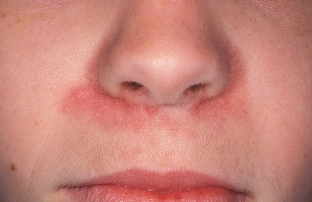This peculiar skin dermatitis is known to specialists under the name of stewardess disease, since women in this profession, as many believed, were forced due to the specifics of the work, use cosmetics in large quantities. Indeed, one of the provoking factors in the development of perioral dermatitis can be the intensive use of make-up or low-quality cosmetics. Today, other irritants are known that can cause inflammation of the skin of the face in the perioral region. Perioral dermatitis has specific & nbsp; signs and easily passes if you get rid of the irritant in time and start treatment.
Who and why perioral dermatitis may develop
Not all dermatologists are ready to distinguish perioral dermatitis as a separate nosology, considering this disease as one of the manifestations of rosacea or eczema. The peculiarity of perioral dermatitis, compared with rosacea, is that it easily passes if the source of irritation is removed, although it can recur again. In the development of the disease, according to experts, a certain role is played by hereditary predisposition, as well as increased sensitivity of the skin, its dryness. Among the provoking factors that cause inflammation of the skin in the area of the nasolabial folds, chin and the area around the mouth, the following are distinguished:
- errors in nutrition (abuse of spicy spices), use of citrus fruits;
- cosmetics (especially those containing lauryl sulfate, paraffin, cinnamon extract);
- allergic to soap, washing powders, detergents;
- fluorinated toothpaste.
Perioral dermatitis may develop with prolonged use of steroid ointments. In addition, stress and nervous breakdowns are a frequent provoking factor. It happens that perioral dermatitis develops against the background of prolonged exposure to the active sun or frequent visits to the solarium.
How does perioral dermatitis manifest in patients
The first manifestations of perioral dermatitis are slight redness on the face, which is aggravated by hot food or spicy foods eaten. Further, the spots become more persistent, acquire a slightly bluish tint, small semicircular nodules appear against their background, and pustules form in the center of such nodules. Thus, outwardly, the disease resembles both dermatitis and rosacea.
Inflammation of the skin affects the area around the mouth – and a light, untouched border remains near the lips – nasolabial folds, chin, sometimes covers the cheeks, forehead, bridge of the nose, lower eyelids. Foci inflammation in oral dermatitis is always symmetrical – on the right and left of the face, they can be grouped, but do not merge.
The signs of the disease develop quite quickly, with adequate treatment there is no protracted course. The patient most often does not experience any subjective sensations from rashes. When the source of skin irritation is removed, the rash dries up, becomes covered with crusts and gradually heals. Temporary pigmentation remains in its place, there is peeling of the skin.

Treatment of perioral dermatitis and its possible complications
If the patient does not turn to a dermatologist in time, perioral dermatitis is more severe than usual: the nose and lips swell, the face swells a little, the skin thickens in the inflamed areas, they show signs of rosacea. The skin lesion captures the border of hair growth and can go to the scalp. This stage of the disease is much more difficult to treat, relapses constantly occur, swelling of the nose persists.
The principle of treatment of perioral dermatitis is to eliminate the substance that causes skin irritation, to stop diseases that have become a possible provoking factor in its development, the abolition of drugs that cause the appearance of dermatitis. If necessary, local application of corticosteroid ointments, B vitamins are prescribed to the affected areas, physiotherapy procedures are recommended.
A patient with perioral dermatitis should be warned that he should avoid excessive insolation and high temperatures (for example, in baths and saunas), diet, try to avoid stress and overwork in order to prevent recurrence of the disease.







Add a comment